If your thing is shred solos, guitar heroics, or endless jams, then Underøath—a heavy metal, post-hardcore, somewhat mathcore band from Tampa, Florida—might not be for you. “We’ve always been energy- and vibe-focused,” says guitarist Timothy McTague. “That’s really a different way of songwriting than, ‘How much shit can we fit in a five-pound bag?’ We’re not about, ‘You do a drum solo, then I’ll do this weird lick, then the bass will slap, then whatever …’ That’s just so tired to me. It gets exhausting to even think about.”
Instead, Underøath’s approach is song-centric. No fuss. No mess. No distractions. “Our songwriting process has evolved around the song being king,” McTague continues. “The vision is king. Everyone plays to that unified vision rather than, ‘How fast can we go?’”
Not that their songs aren’t fast. They can be. They can be heavy, too. Underøath is a metal band, after all. They even have a funky “Ø” in their name. It’s just that their focus is collective and emotional. Underøath’s current lineup—which, in addition to McTague, also features James Smith on guitar—came together in 2004 at the time of their fourth release, They’re Only Chasing Safety.
Their profile grew with subsequent releases and two Grammy nominations, until they disbanded in 2013. But that breakup was short-lived, and two-years later they were back—although it took until 2017 to record the just-released Erase Me, which is their first studio album in eight years.
Erase Me is also their first effort to develop organically. “Historically, the band had always locked itself into a rehearsal space to write a new record,” Smith says. “Someone would come in with a riff or idea, which led to another part or another idea, and there was always that lockdown, like: ‘We’re not leaving until it’s all here.’ This time the band had taken a break for a few years. Some members had pursued other projects and had songs that weren’t being used or that weren’t the right mood or setting for those other projects. Some of us brought these ideas to the table, sent them around, and from there started developing them individually with Pro Tools. By the time we hit the studio, there were a few songs that were in a good spot to record.”
“We had a lot of different writing processes on this one,” McTague adds. “I think it shows, in that the record is super-dynamic. It is not as themed as our others, but it is also much more diverse.”
To learn more, we spoke with McTague and Smith about Erase Me, how they divvy up guitar duties, their unique approach to polyrhythms, their recent embrace of amp modeling, and their unbending—although officially unofficial—policy of never taking guitar solos.
Was Underøath already touring when you joined the band?
Timothy McTague: They were. The band was around for about two-and-a-half years, played a couple of cool festivals, signed to Takehold Records—which was a small indie label in Birmingham, Alabama—and released two albums. I was already in the band at the point The Changing of Times came out.
James Smith: I was playing in different bands and along the way I met Grant Brandell, the bass player in Underøath. We played in a ska band together in high school, and then we tried to transition to a heavier hardcore type of band. He was always pretty serious about music—as I was—but I also had my parents at home drilling into me, “You have to go to college and figure out a professional path to your life.” So I had a little bit more of that focus. He ended up joining Underøath to pursue full-time music. I stayed in school, played in some other bands, but really wasn’t happy to focus on school. Then the opportunity came up within Underøath: Their guitar player was going to leave. I was on that guitar player’s last tour—just offering my services. I was the merch guy for a few weeks, and from there was able to befriend everybody and get to the top of the list for tryouts. I plugged in, was able to play along, and then after that we were off and running. They didn’t need to try out anyone else.
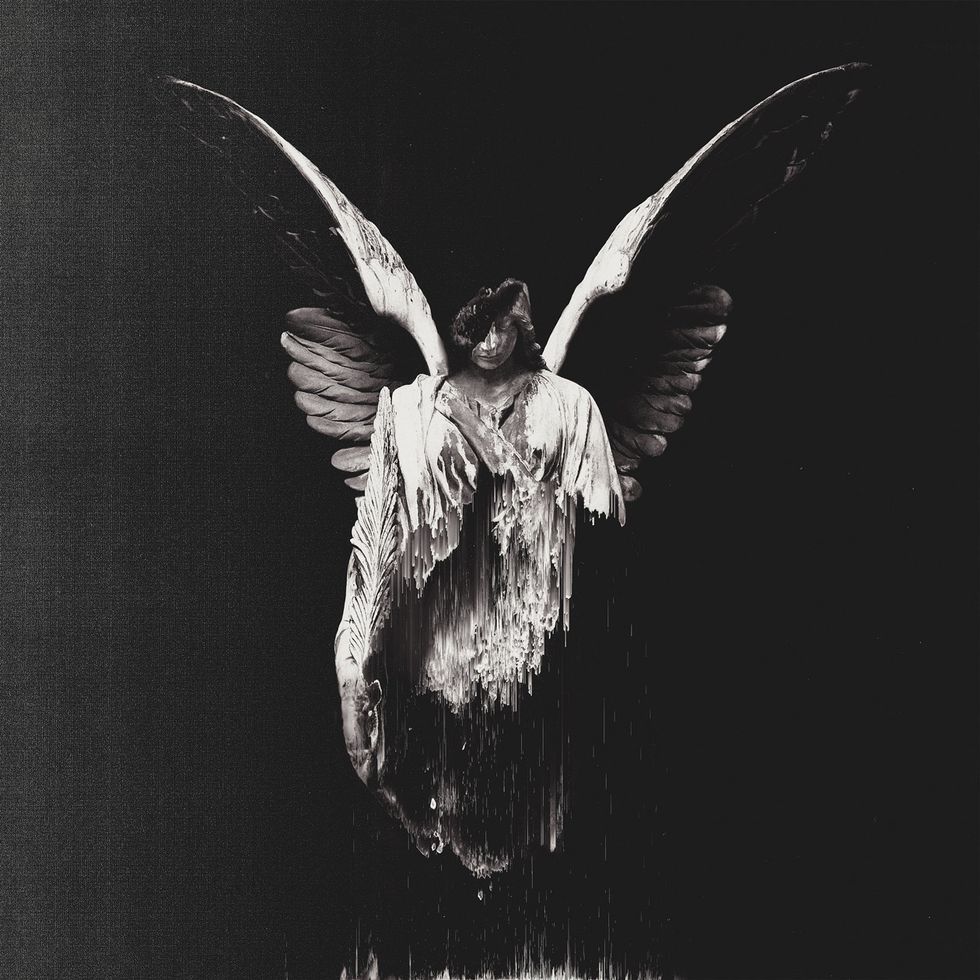
TIDBIT: Timothy McTague played all the guitar and bass tracks on the band’s new album. But, he says, “I usually play all the lead stuff and James plays all the rhythm stuff.”
Was it difficult to find your voice within the band?
McTague: It wasn’t hard to find my voice, because when I tried out there were two guitar players, Corey Steger and Octavio Fernandez [who originally joined as bassist], and one of them was leaving. Corey wrote everything and Octavio basically played what Corey told him, and I thought I was replacing Octavio. I was like, “Man, that’s a dream come true. I’ll get to learn from a great songwriter and I’ll just be under Corey.” But then I realized that Corey was the one who was leaving.
I remember Octavio telling me, “You are going to have to take on a lot of writing for the new record, because none of us really write.” So it wasn’t like I had a mold I had to fit into. It was more that the dude who literally told everyone what to do just left. For the first time in the band’s lifetime everyone got to sit and think, “Who do I want to be?” Instead of, “This is what I am told to be.” That was really cool, because I wasn’t an established songwriter. I couldn’t do it all and I didn’t do it all. That was a big question in the conversations I had with the guys. I think it unlocked Chris [Dudley, keyboards] and Aaron [Gillespie, drums and vocals] to really become the hyper-creatives that they have blossomed into.
James Smith poses with his Fender Telecaster HH. He and McTague have swapped their amps and their pedals for Fractal modelers. “I am trying everything in the Fractal and I haven’t been disappointed yet,” Smith notes. Photo by Dan Newman
Let’s talk about playing in odd meters. Do you do that on purpose or is that just how it works out?
Smith: It is a little bit of both. We’re trying to capture the feeling and not so much trying to play the odd time signature. From a musical standpoint, our goal isn’t necessarily guitar-based. It’s more mood, sound, feeling, and emotions. However that speaks and translates musically is how it speaks and translates musically.
McTague: I think 4/4 timing with a 3/4 riff over it looping back [on the 12th beat] is one of the cooler moments in the music we play. What I really like is, as you’re listening, getting a little of that vertigo for a bit—and then it resets every four bars. But that’s not really a theory thing. I don’t know theory. I can’t read music. I don’t know what key songs are in.
I intentionally kept music theory out of my life, because I don’t think it’s ever done people good when they are trying to be creative. Obviously, there’s Jonny Greenwood [Radiohead] and Hans Zimmer [film composer], and these people are geniuses both technically and creatively.
But by-and-large, especially in heavy music, you can tell who are the guitarists that took guitar lessons for five years. It’s Between the Buried and Me. It’s Animals as Leaders. It’s so technical, because they think technically. I love those guys and we’ve toured with them, but that’s never been something that I’ve wanted to do. We’ve never had a guitar solo on a song and we never will. I think playing together to create a massive typhoon of color/emotion/feeling is much more important than me sticking out and people saying, “Dude, that guy is so sick at guitar.” For me, one of the special things about Underøath is we’ve always been energy- and vibe-focused. We play as much or just enough to where it gets the point across.
So, not taking solos is part of the band’s philosophy?
McTague: One-thousand percent. Though I don’t think it’s our philosophy. If you bumped into Grant or Chris and said, “Dude, I heard about your no-solo policy.” They would be like, “What do you mean?” It’s just that we have never been interested in solos and we just don’t do them. And we never will. If there was a point where it made sense … but I don’t think I’ve ever heard a guitar solo that makes sense. I get why they’re there. But why they’re there is everything that I am not trying to be. I don’t care about those things. I am impressed when you do it, but I don’t want to do it.
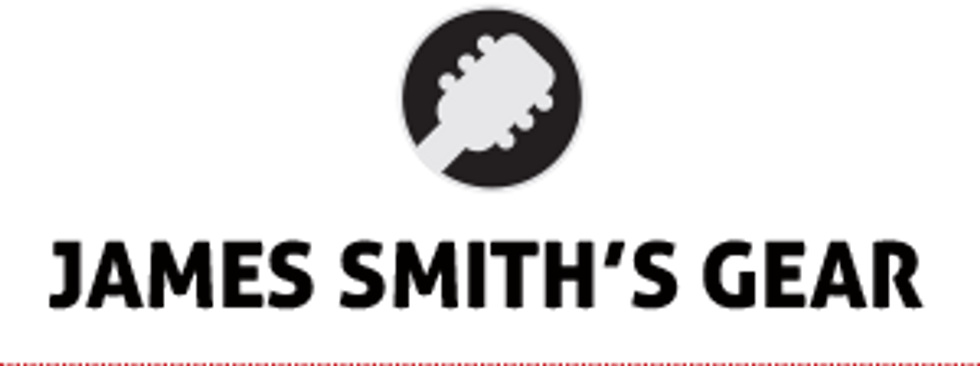
Guitars
Fender Telecaster HH with Seymour Duncan JB humbucker in the bridge position
Fender Jaguar Baritone Custom
Amps and Effects
Fractal AX8 Amp Modeler/Multi-Fx Processor
Strings and Picks
Ernie Ball (.011–.052)
Wedgie 1 mm
Smith: It’s more a lack of ability, I think. Also, it’s never really been a pursuit of ours. We’ve always played through the emotion and the soundscape of the song. Neither one of us are overly talented shredders by any stretch of the imagination. We leave that up to the guys who are. Also, I feel that it can get in the way of what you’re trying to create. It’s just highlighting ability instead of highlighting the song structure and songwriting.
As a two-guitar band, how do you define your roles?
McTague: On the record side, I record all of the guitars.
In general, or just for Erase Me?
McTague: Not in general. James has recorded on every record except this one. It is a weird thing. It is not a super-fun thing to talk about, but I think me, Aaron, Chris, and Spencer [Chamberlain, vocals] got to a point where we realized that we four have always been the main writers. It seems that it makes way more sense for us four to go in and write and record the album, rather than having everyone there and certain things not be efficient, creative, agile. So we took that route on this one. Generally, as far as divvying up parts—and this is for this record and every record—I usually play all the lead stuff and James plays all the rhythm stuff. When we have a part with three overdubs, he and I put our heads together and go, “Which way are we going?” He does the rhythms, I do the leads. Though I don’t like being called the “lead guitar player.” Yuck. But I do all the ambient noodle-y stuff. That’s how it’s always worked. James is super strong. He’s really great at rhythms. I am pretty good at creating a vibe with the delay pedal, bends, and getting a little more emotional. It works. We have a rock-solid rhythm section and that allows me to get a little more noisy and bring a new element live to everything.
Smith: I stood back on this record and let Tim explore and envision things. He was writing non-stop and these songs were coming from a place for him to really take the reins. He did it better than I could. I would just be more in the way. Tonal-wise, Underøath has always been two distinct guitar sounds. He mostly plays lead. The only times a lead will shift over to my side of the stage is if he has a vocal going on or something else that allows him not to play it as full. I am always there to support him. That’s the way I look at my role in the band: It is to support what we’re trying to create, and I am always down to do whatever.
Eschewing the conventions of metal and guitar, Timothy McTague sticks to emotional shadows and light on tour and in the studio. “I do the leads,” he explains, “though I don’t like being called the ‘lead guitar player.’ Yuck.” Photo by Dan Newman
Tim, did you play bass on the album, too?
McTague: Yup. I did. Every stringed instrument was played by me.
What guitar tunings are you using?
Smith: On this record, we’re in four different tunings, which is going to add to the guitar vault, for sure. We’re playing baritone in B standard [B–E–A–D–F#–B], plus drop C [C–G–C–F–A–D], drop C#, and drop D.
McTague: We’ve ordered six new guitars since we got out of the studio. Trying to put together a set is mind numbing, because it is basically a guitar change every single song. In the studio, we had the same tuning problems—four tunings and one guitar—so before we got started, I had an EverTune bridge put onto the Les Paul and had it setup for drop C. If we needed C#, we just put a capo on the 1st fret. Drop D—capo the 2nd fret. We played the same guitar in one tuning for all of the tunings and hacked the system.
You don’t want to bring that guitar on the road?
McTague: No. That’s our studio guitar. EverTune is great for keeping things in tune. It has a reaction time. If you want to be bendy and vibey, it’s just a lot of work, and I have so many songs that I bend in and need human reaction. When you have time to readjust the tension in the studio, you can do that, but live, that’s just another thing I have to think about.
What are you using for amps? I saw a few pictures of a stack of heads ... a Matchless, a few Oranges.
Smith: That’s Tim’s Matchless. We both have Oranges. I have a Marshall JMP from the late ’70s.
Are you using those on tour?
Smith: Up until now. We just made the switch to Fractal. We’re in a whole new world of digital amp modeling. It’s been a weird transition, but we’re giving it a try. We can see the benefits and it’s sounding good so far.
Do you run into cabinets or straight to the board?
Smith: They’re going straight to the board.
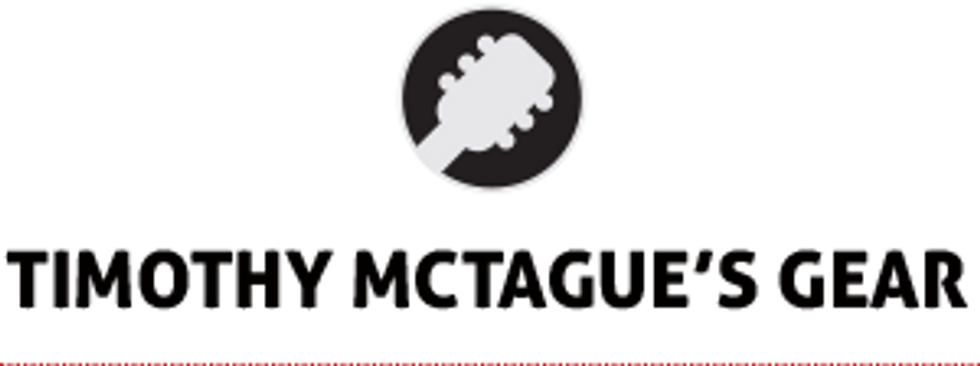
Guitars and Basses (studio)
Gibson Les Paul with EverTune bridge and Seymour Duncan JB humbucker in the bridge position
Gibson Les Paul Studio Baritone
Fender American Deluxe Active Jazz basses (4-string and 5-string models)
Guitars (live)
Gibson SG
Fender Telecaster
Fender Jaguar
Fender Jaguar Baritone Custom
Amps
Orange Dual Terror
’70s Marshall JMP
Fractal Axe-Fx II XL+ (live)
Effects (studio)
DigiTech Whammy
Ibanez Tube Screamer
Soundtoys plug-in suite (including EchoBoy delay)
Strings and Picks
Ernie Ball (.011–.052)
Wedgie 1 mm
So it’s a lot quieter onstage.
Smith: It has always been pretty quiet for us. We play with in-ears and we’ve always stripped the monitors off the stage. To give our front-of-house more control, our cabs have always faced the back of the stage, isolated.
McTague: It’s an interesting thing when you think about using something that is just a DI-out. The cool thing about it: It’s all about how it sounds when it comes out of a PA. If we’re using a weird PA and there is a funky midrange frequency, we can flick a filter on that Fractal and make sure it sounds the right way every night, which is cool. Now, even when we fly to Australia, we’re not fighting with crappy rented gear. It is just going to be the same every night. On top of that efficiency and consistency, the sound and overall tone is amazing. I’m really excited. We toured with Animals as Leaders 10 years ago, and Tosin [Abasi] had a Fractal. I was like, “That’s voodoo. I can’t even understand what that is.” But he sounded amazing every night! Sure enough, 10 years later I am, like, “What’s up with these things?”
I have been programming all of my footswitch changes through our stage computer. I have the Fractal connected to Ableton Live and it is sending MIDI notes to all of my patches. They are changing, in real time, automatically, directly on the millisecond that it should—rather than having to stand in front of an MFC-101 [switcher] and be tripping over it and hitting wrong buttons. I am not the most graceful onstage.
And no pedals? It’s all in the Fractal?
McTague: Everything.
Smith: I’m trying everything in the Fractal and I haven’t been disappointed yet. I feel like I am at such a beginner stage, but at the same time I am getting everything accomplished that I want to. It’s not as easy as just plugging in that pedal that you saw your buddy playing and capturing that sound. Rather, it’s like, “What does Fractal call this pedal? What is that pedal trying to do? What is everything I have to change to emulate that?” It takes a lot more work, but I am happy with the results.
Did you still use pedals in the studio?
McTague: We did. We always had a Tube Screamer on. We had a piece-of-crap wah and a red DigiTech Whammy. It has a detune function, and in preproduction we were able to use it when discussing keys. That was it. I am an engineer myself, and a producer, and I’ve fallen so in love with Soundtoys, which is a plug-in suite. They have a delay pedal [plug-in] called EchoBoy, and it is one of the best sounding delays ever.
A lot of the effects, aside from pure crunch and tone, we were doing in the box. At this point it’s weird to say, but I’ve never cared about amps and I’ve never cared about guitars. Some people have amp collections. I’ve always had two crappy guitars. I swap out the pickups. I rip all the guts out. Now it is enabling my ability even more to not care about technical things both in terms of playing and with hardware. I know [Fractal’s] Axe-Edit. I know Ableton. I am going to do all the hard work in the background in my lab, so when I get onstage I can just go.
YouTube It
Doubling up on Telecasters, Timothy McTague and James Smith pack plenty of 6-string wail into this 2018 version of “Writing on the Walls” from Underøath’s 2006 album, Define the Great Line. The official studio video for the song was nominated for a Best Short Form Music Video Grammy.




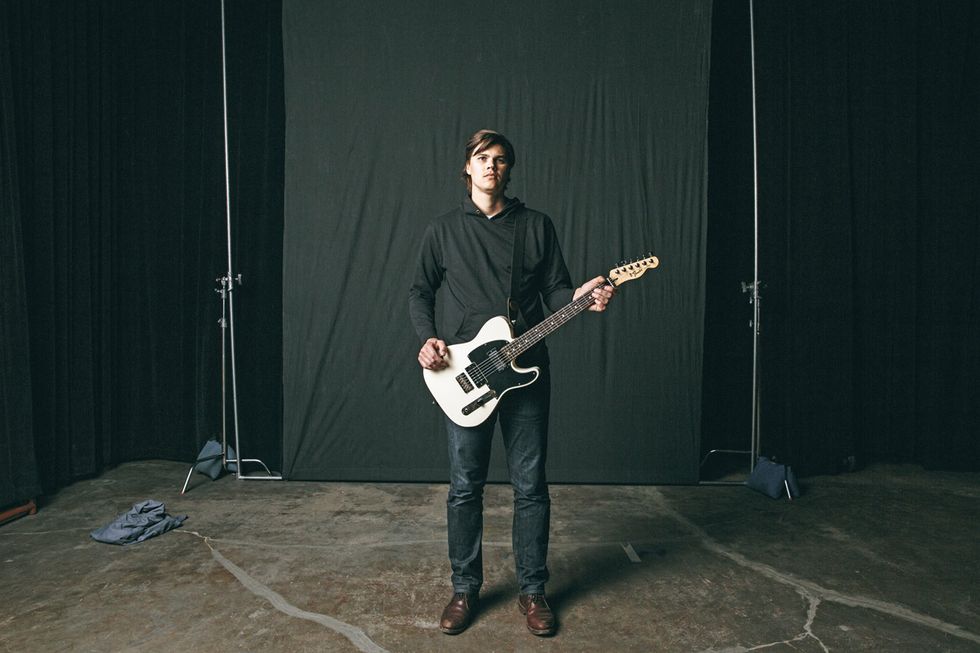
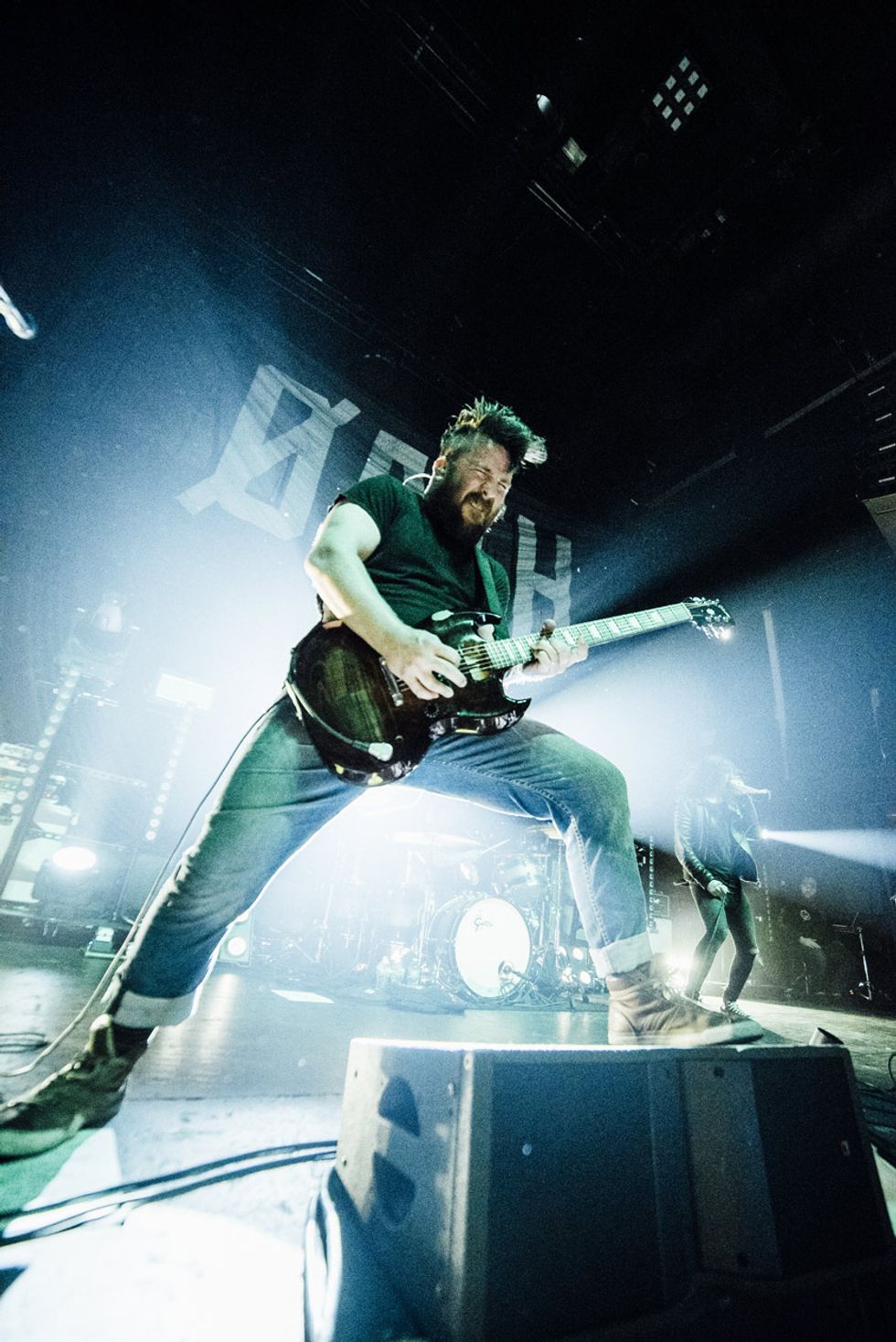








![Rig Rundown: Russian Circles’ Mike Sullivan [2025]](https://www.premierguitar.com/media-library/youtube.jpg?id=62303631&width=1245&height=700&quality=70&coordinates=0%2C0%2C0%2C0)












![Rig Rundown: AFI [2025]](https://www.premierguitar.com/media-library/youtube.jpg?id=62064741&width=1245&height=700&quality=70&coordinates=0%2C0%2C0%2C0)




















 Zach loves his Sovtek Mig 60 head, which he plays through a cab he built himself at a pipe-organ shop in Denver. Every glue joint is lined with thin leather for maximum air tightness, and it’s stocked with Celestion G12M Greenback speakers.
Zach loves his Sovtek Mig 60 head, which he plays through a cab he built himself at a pipe-organ shop in Denver. Every glue joint is lined with thin leather for maximum air tightness, and it’s stocked with Celestion G12M Greenback speakers.











